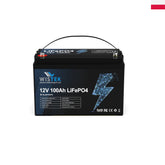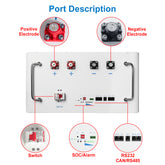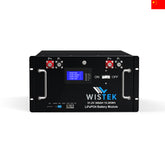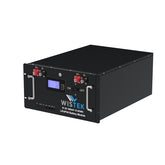What Happens When You Use a 40V Battery in a 20V Tool
Using power tools correctly is essential for both performance and safety. One of the most common questions DIY enthusiasts and even professionals ask is, “What happens when you use a 40V battery in a 20V tool?” This is a question with serious implications. The battery you use must be compatible not only in size and type but also in voltage. In this article, we’ll explore what could happen if you try this voltage mismatch, why it's risky, and what better alternatives are available.
- Understanding Battery Voltage Differences
- Battery Compatibility Is Not Just About Fitting the Slot
- Battery Risks: What Could Actually Happen
- Battery Safety Concerns You Should Not Ignore
- Why Voltage Ratings Exist on Every Battery and Tool
- Alternative Solutions Instead of Mismatching Battery Voltage
- Battery Life and Longevity When Using the Wrong Voltage
- Common Myths About Using Higher Voltage Batteries
- How to Identify the Right Battery for Your Tool
Understanding Battery Voltage Differences
What Does Battery Voltage Mean?
Battery voltage represents the electrical potential a battery can deliver to a device. In power tools, voltage is one of the primary indicators of how much power a tool can generate. A 20V battery supplies a certain level of energy that the tool is specifically designed to handle. On the other hand, a 40V battery offers double the voltage, which can dramatically impact a tool’s internal components.
The higher the voltage, the more power the tool can potentially receive—assuming it’s built to handle it. But when a tool rated for 20V is connected to a 40V power source, the result is almost always damaging.
How Battery Voltage Affects Power Tools
Voltage directly affects the speed, torque, and overall performance of a tool. Most 20V tools are designed with specific electrical tolerances, safety mechanisms, and battery communication protocols. A 40V battery might seem like a good way to get more performance, but the reality is that it can lead to irreversible damage or even dangerous malfunctions.
>>See also Is 15 Volts Safe for a 12 Volt Battery
Battery Compatibility Is Not Just About Fitting the Slot
Physical Fit vs. Electrical Compatibility
Many people mistakenly believe that if a battery fits physically into the tool's battery compartment, it should work. But battery compatibility is far more complex than just matching the shape and size.
Battery management systems (BMS) are often built into both the battery and the tool. These systems communicate to ensure voltage, temperature, and current levels are safe. Inserting a 40V battery into a 20V tool can completely bypass these safeguards.
Brand-Specific Battery Systems
Most major power tool brands have proprietary battery and charger systems. For example, DeWalt, Makita, and Ryobi design their 20V and 40V lines to be completely separate. Trying to use a 40V battery in a 20V DeWalt tool, for example, may not only void your warranty but also destroy your tool.
Battery Risks: What Could Actually Happen
Immediate Electrical Damage
Connecting a 40V battery to a 20V tool may cause the motor to run far beyond its intended capacity. This can result in overheating, component failure, or even fire. The battery itself may also shut down if it has protective circuitry—but not all batteries are equipped with this safeguard.
Permanent Motor Burnout
The motor windings in a 20V tool are designed for a specific voltage. When over-volted, the motor may spin too fast, produce excessive heat, and eventually burn out. This damage is often irreversible and may happen within seconds of connecting the wrong battery.
Circuit Board Meltdown
Power tools often include a printed circuit board (PCB) that manages power flow and communicates with the battery. Supplying twice the designed voltage can burn through these delicate circuits in an instant.
Battery Safety Concerns You Should Not Ignore
Fire and Explosion Risks
Lithium-ion batteries are powerful and compact—but they’re also volatile under certain conditions. Over-volting a tool with the wrong battery increases the risk of thermal runaway, leading to battery swelling, leaking, or even explosion.
Warranty Voided Immediately
Using an incompatible battery will almost certainly void the tool's warranty. Manufacturers explicitly warn users against mismatched components. Even if the tool appears to function temporarily, any damage caused by incorrect battery use will not be covered.
Why Voltage Ratings Exist on Every Battery and Tool
Built-In Voltage Safeguards
Most reputable brands engineer their tools with voltage-specific locks or communication chips that reject incompatible batteries. These are essential safety features designed to prevent user error and maintain product longevity.
Interchangeability Isn’t Always Possible
Even within the same brand, not all batteries are cross-compatible. A 20V battery system may use different pin configurations and software than a 40V version. Attempting to force compatibility could damage both the battery and the tool.
Alternative Solutions Instead of Mismatching Battery Voltage
Buy the Right Voltage Tool or Battery
The best course of action is always to match the tool and battery as intended. If you have a 40V battery, purchase a compatible 40V tool. Similarly, if your tools are all 20V, stick with 20V battery systems.
Invest in Universal Adapters—With Caution
There are third-party adapters that claim to allow 40V batteries to power 20V tools. However, these should be approached with extreme caution. Many lack essential safety features, and using them often still voids warranties.
Battery Life and Longevity When Using the Wrong Voltage
Faster Battery Degradation
Using a 40V battery in an incompatible tool may cause it to discharge too quickly or unevenly. This can lead to faster cell degradation, reducing overall battery lifespan.
Overheating Issues
Tools not designed for high voltage may lack adequate cooling mechanisms. This leads to not only tool failure but also reduced battery efficiency over time due to frequent overheating.
>>See also How to understand the cycle life of Lifepo4 cell?
Common Myths About Using Higher Voltage Batteries
“More Voltage Means More Power” – Not Always
While technically true in compatible systems, more voltage in an incompatible system is not only useless—it’s harmful. The battery can’t give your 20V tool “extra power” if the internal circuits aren’t designed for it.
“It Works, So It Must Be Fine” – A Dangerous Assumption
Some users report that their 40V battery “worked fine” in a 20V tool. Even if it powers on, hidden damage may be occurring inside the circuitry or motor. The long-term cost far outweighs the short-term gain.
How to Identify the Right Battery for Your Tool
- Check voltage and amp-hour (Ah) ratings on the label
- Consult the tool manufacturer’s manual or website
- Avoid third-party batteries unless officially approved
- Only use original chargers and accessories
Always take time to verify your battery system before making a connection. A few seconds of caution can save you from replacing a ruined tool—or worse.
In summary, attempting to use a 40V battery in a 20V tool is risky, potentially dangerous, and likely to damage your equipment. While it may be tempting to try for more power, doing so disregards critical design limitations set by manufacturers.
The battery is the heart of any cordless tool system. Choosing the correct one ensures your tools last longer, perform better, and remain safe to use. With U.S. and European safety standards becoming increasingly strict, it’s more important than ever to respect voltage ratings.
If you're unsure, always consult with your tool brand's customer support or refer to the product documentation. It’s better to be safe than sorry when it comes to battery and tool compatibility.
























Leave a comment
All blog comments are checked prior to publishing